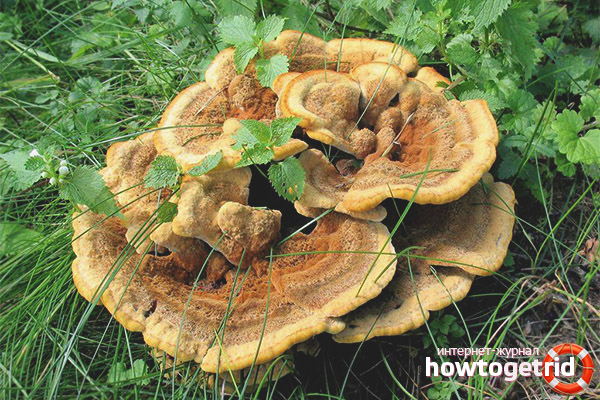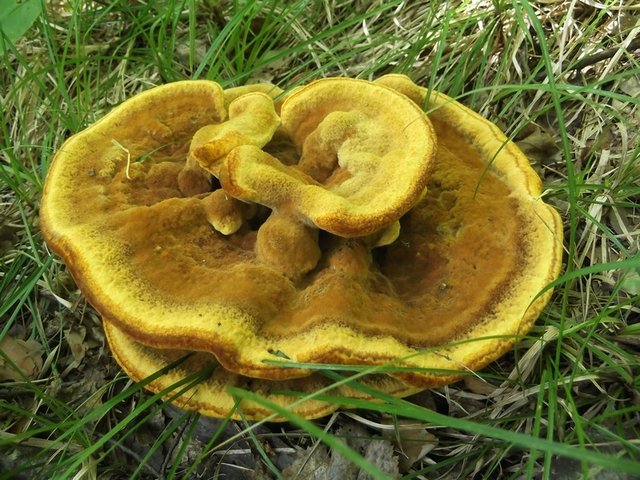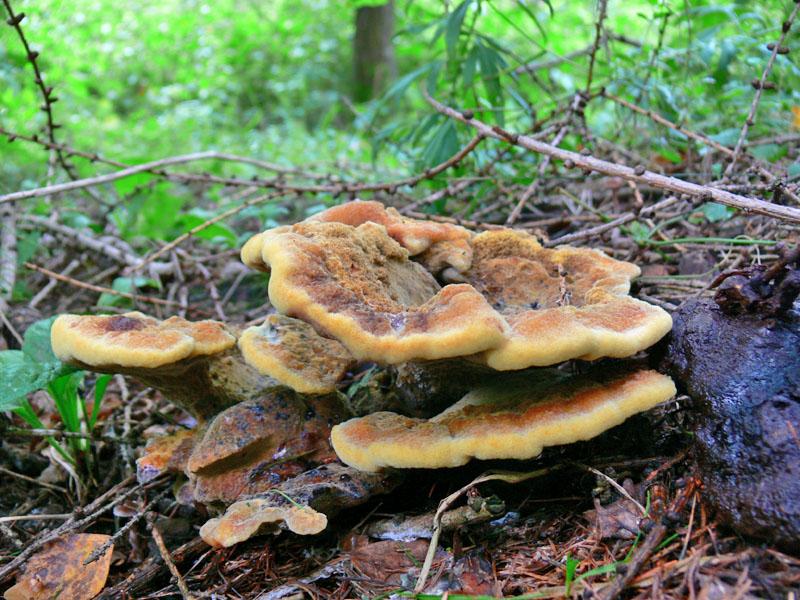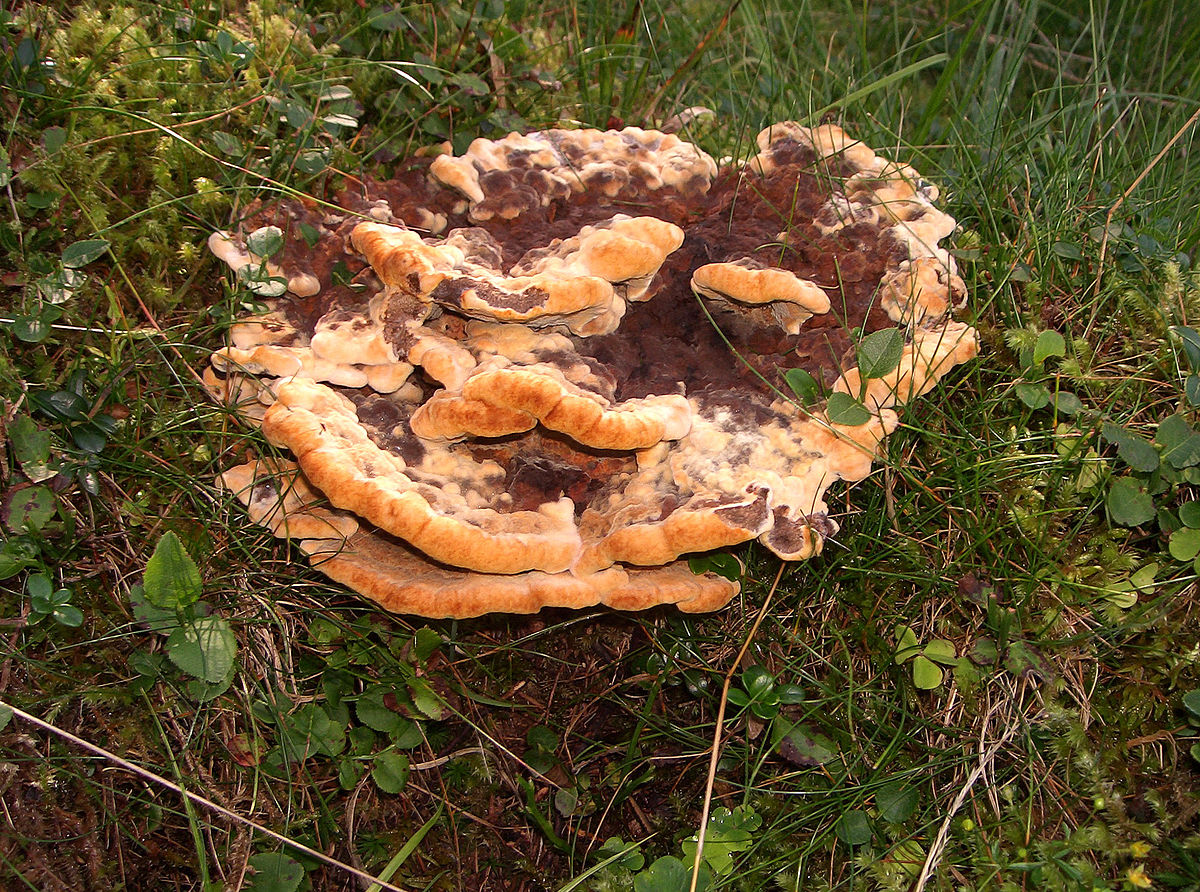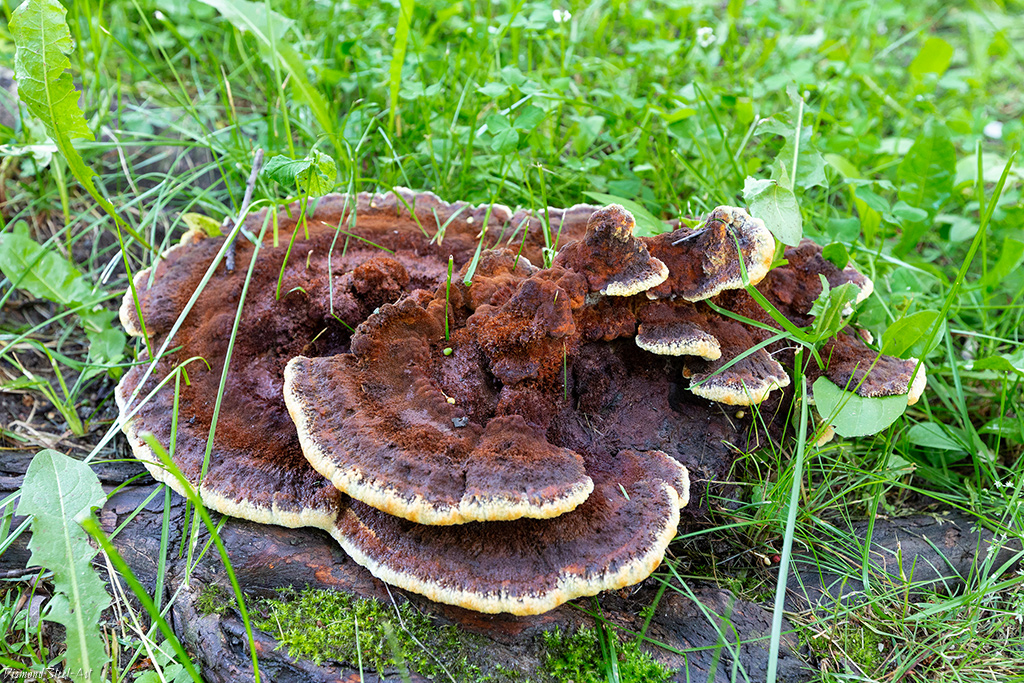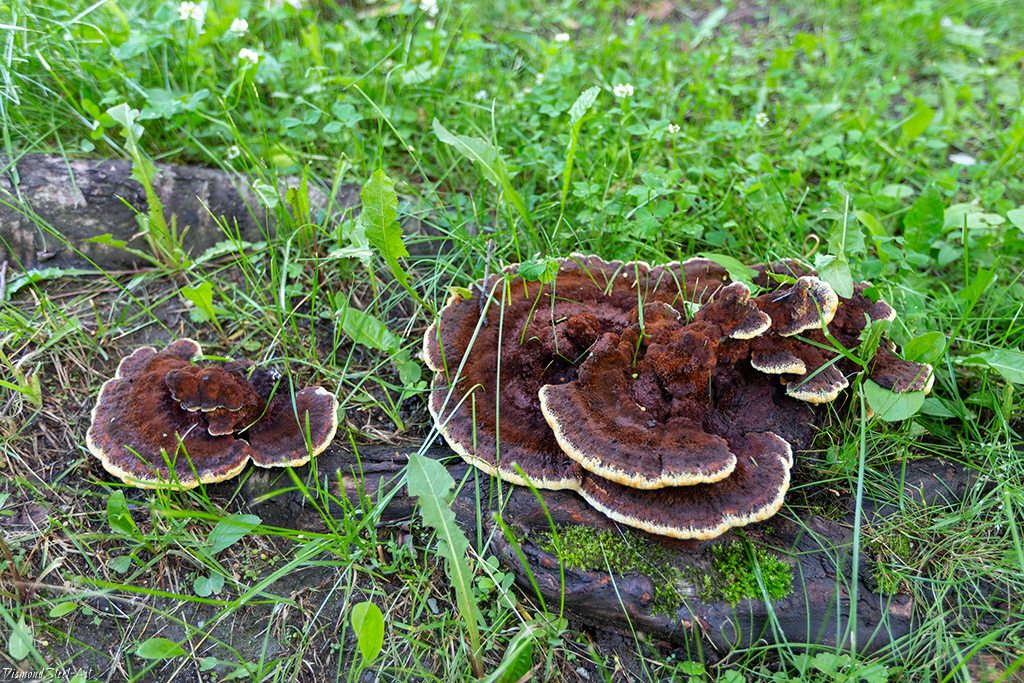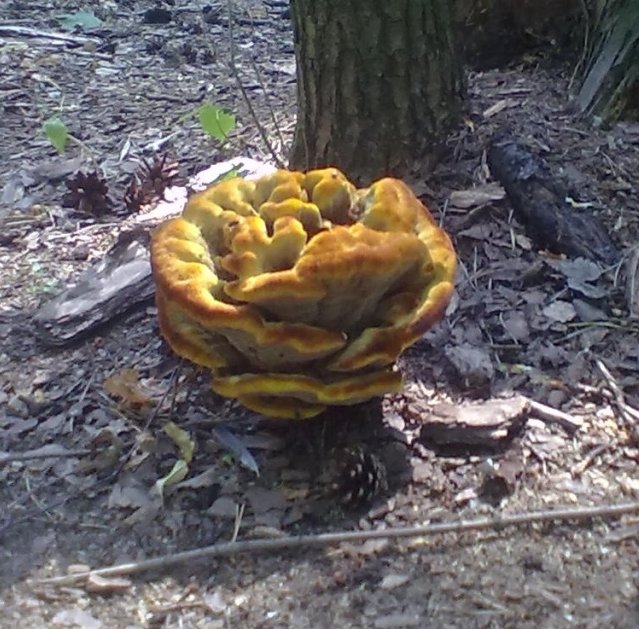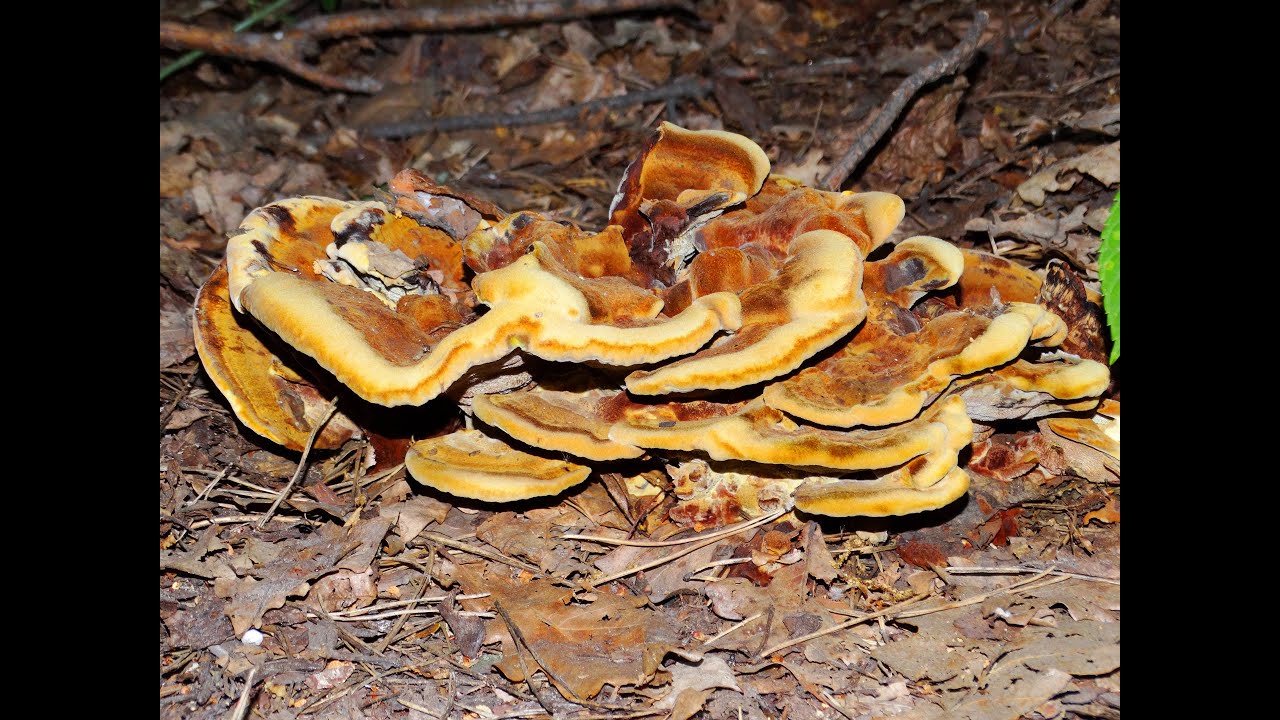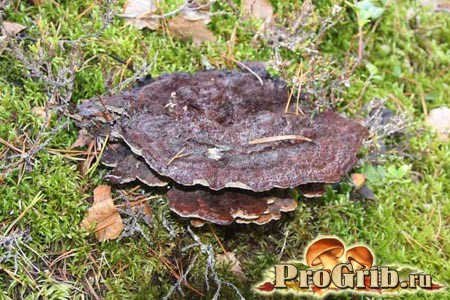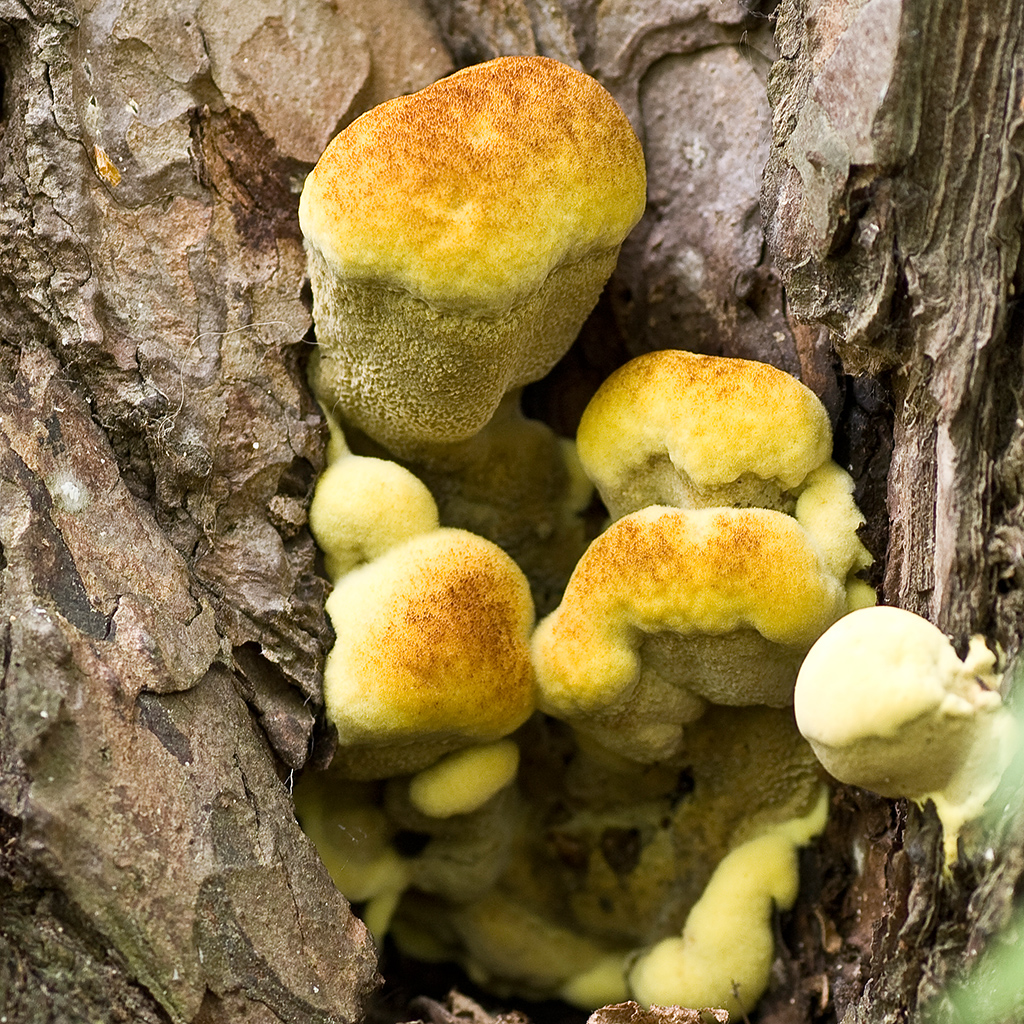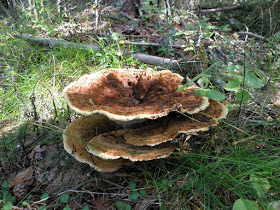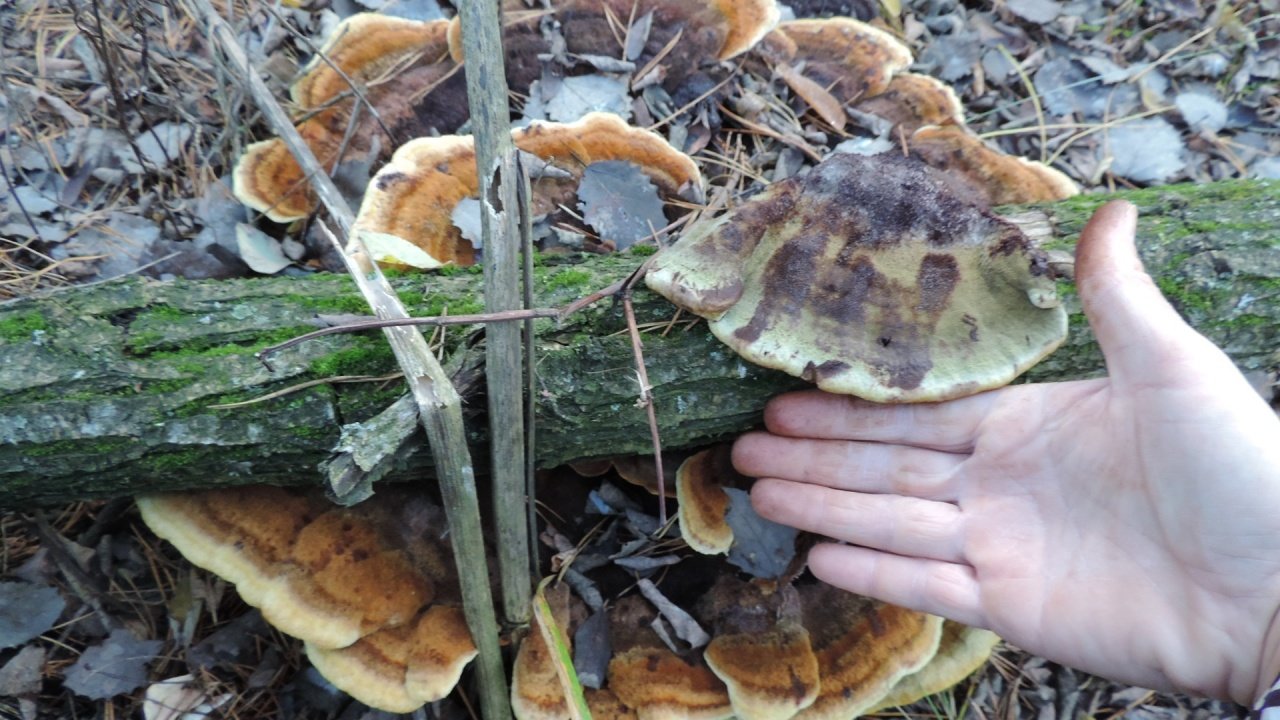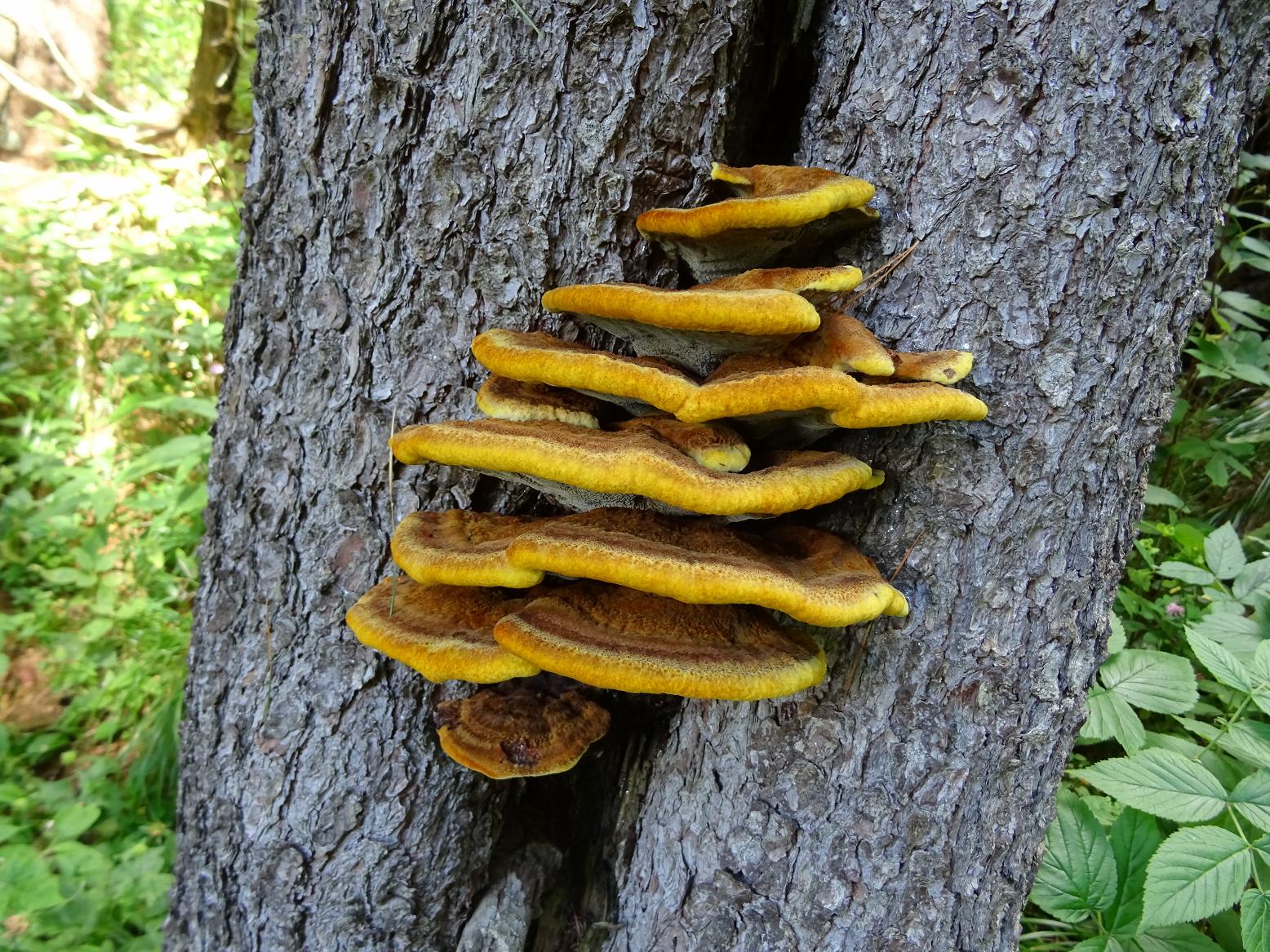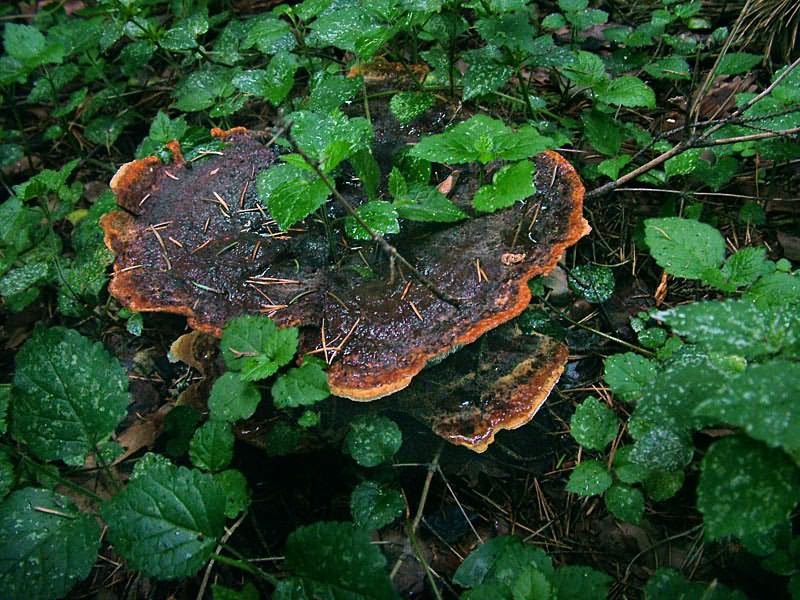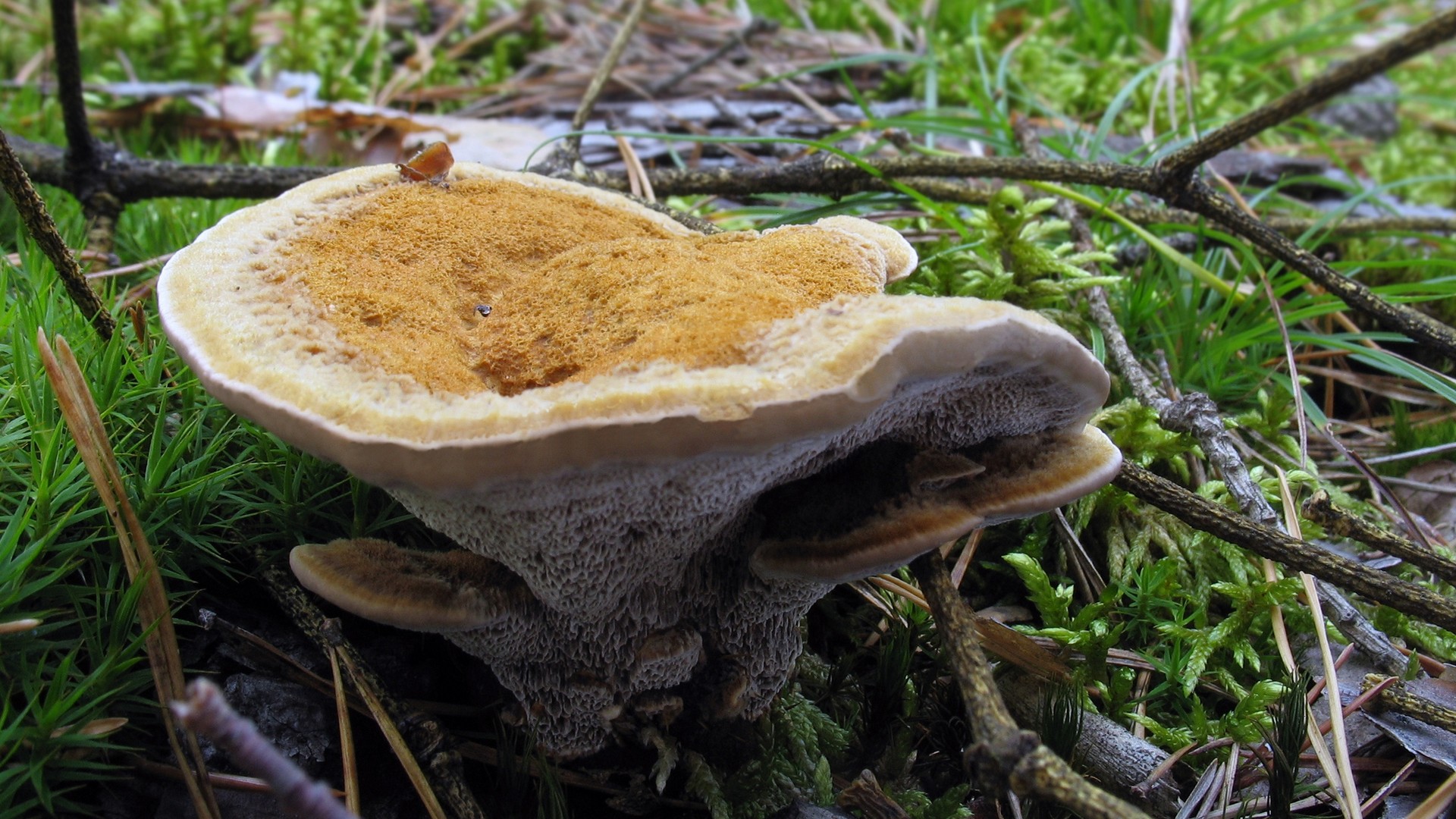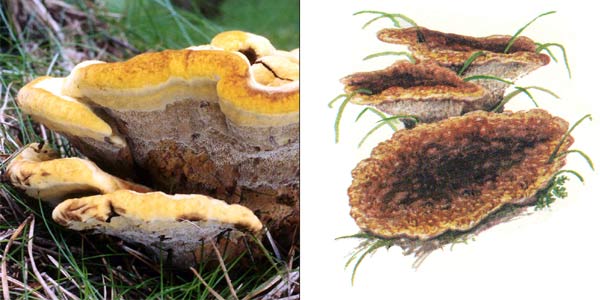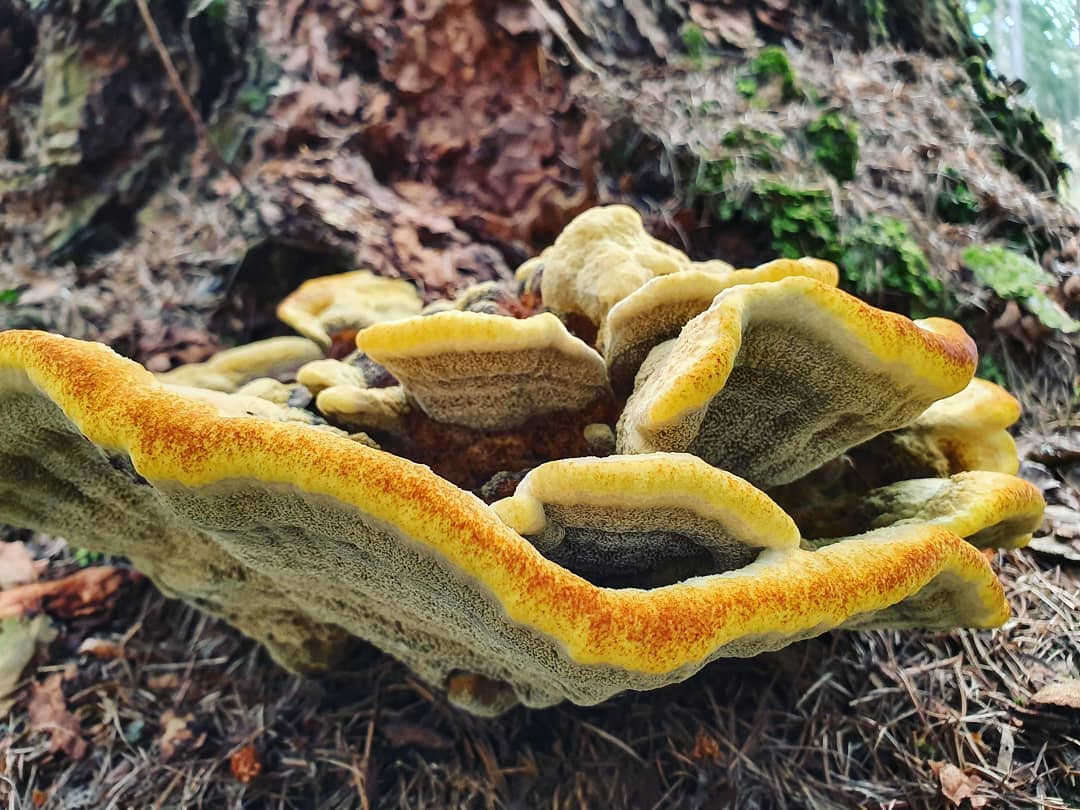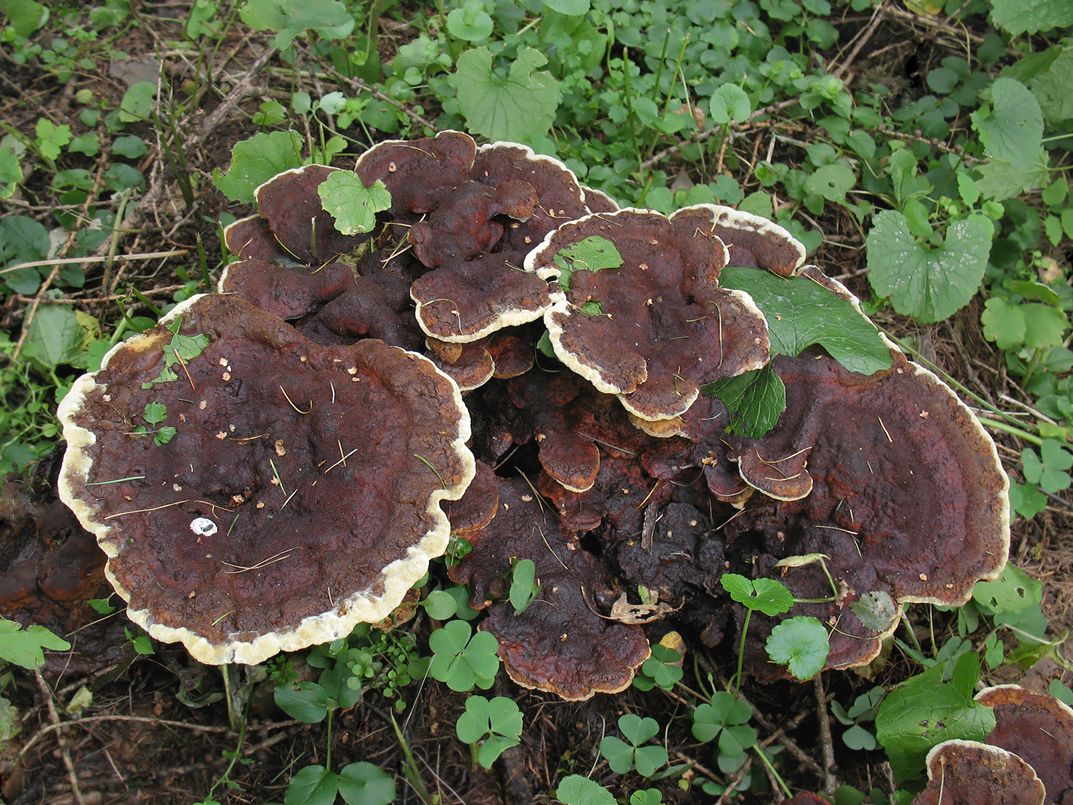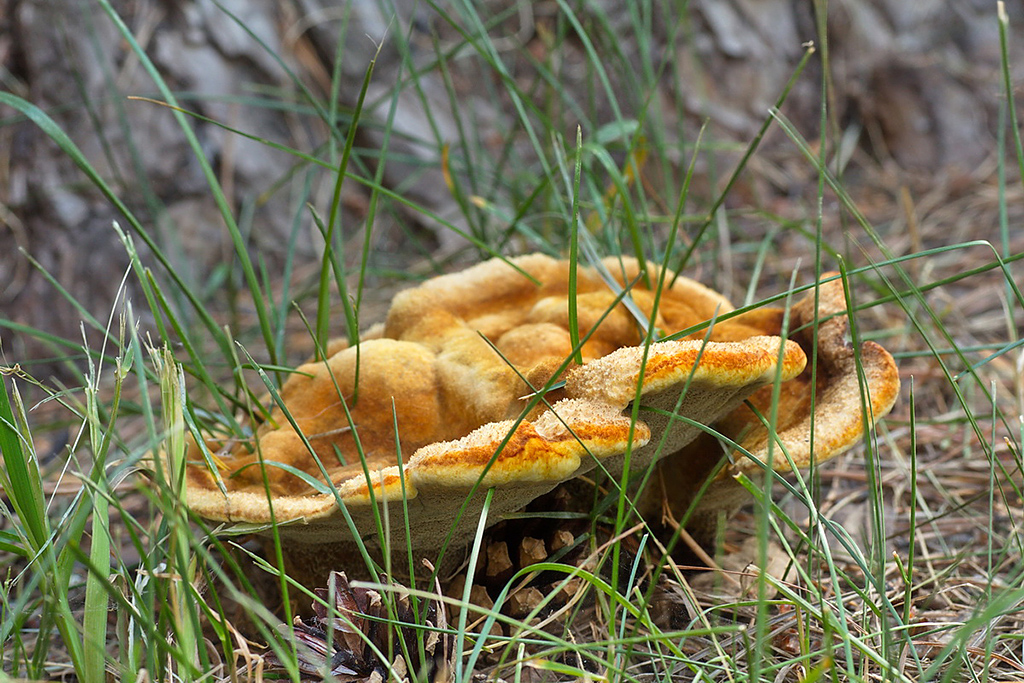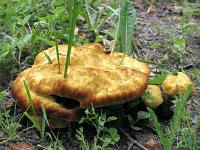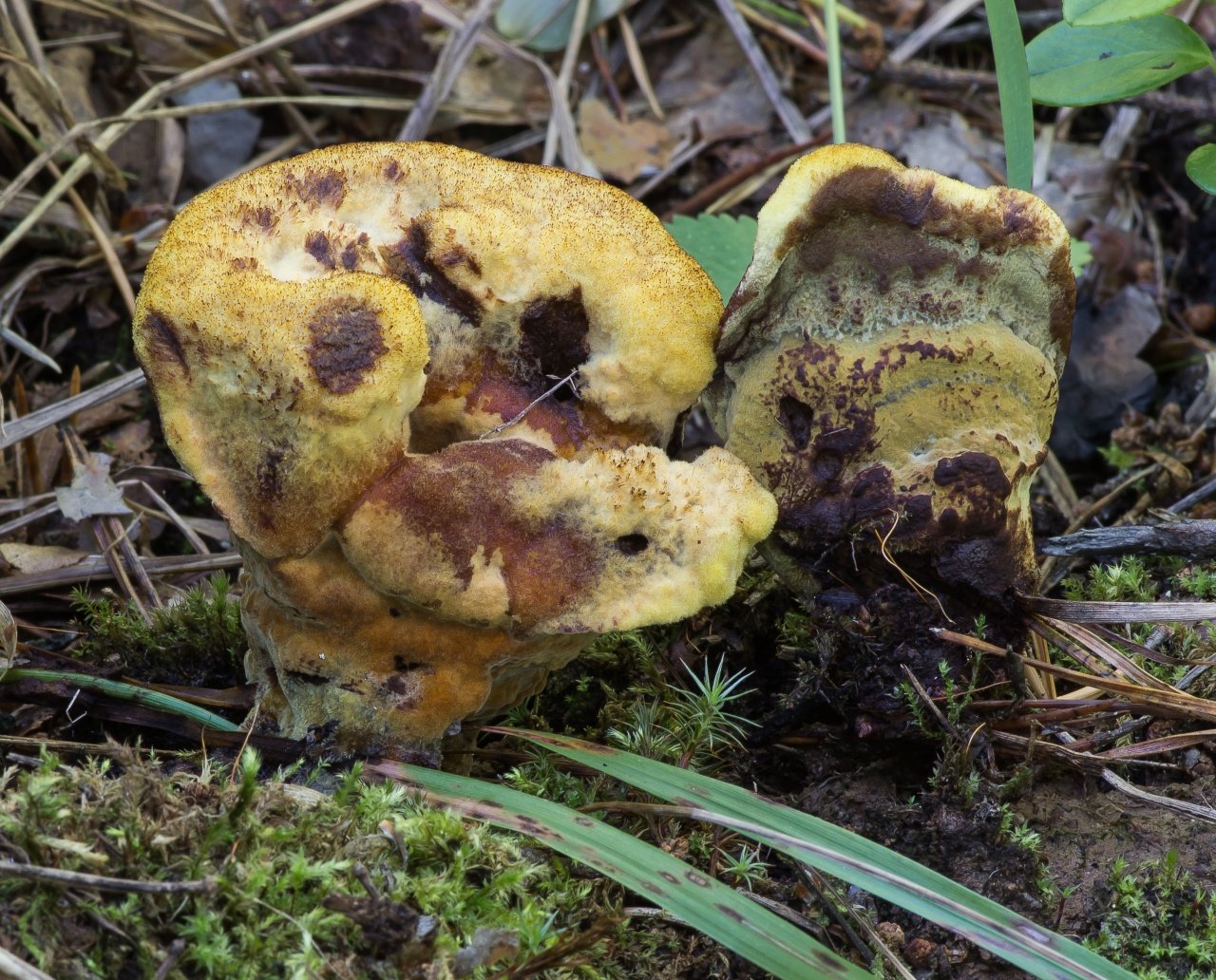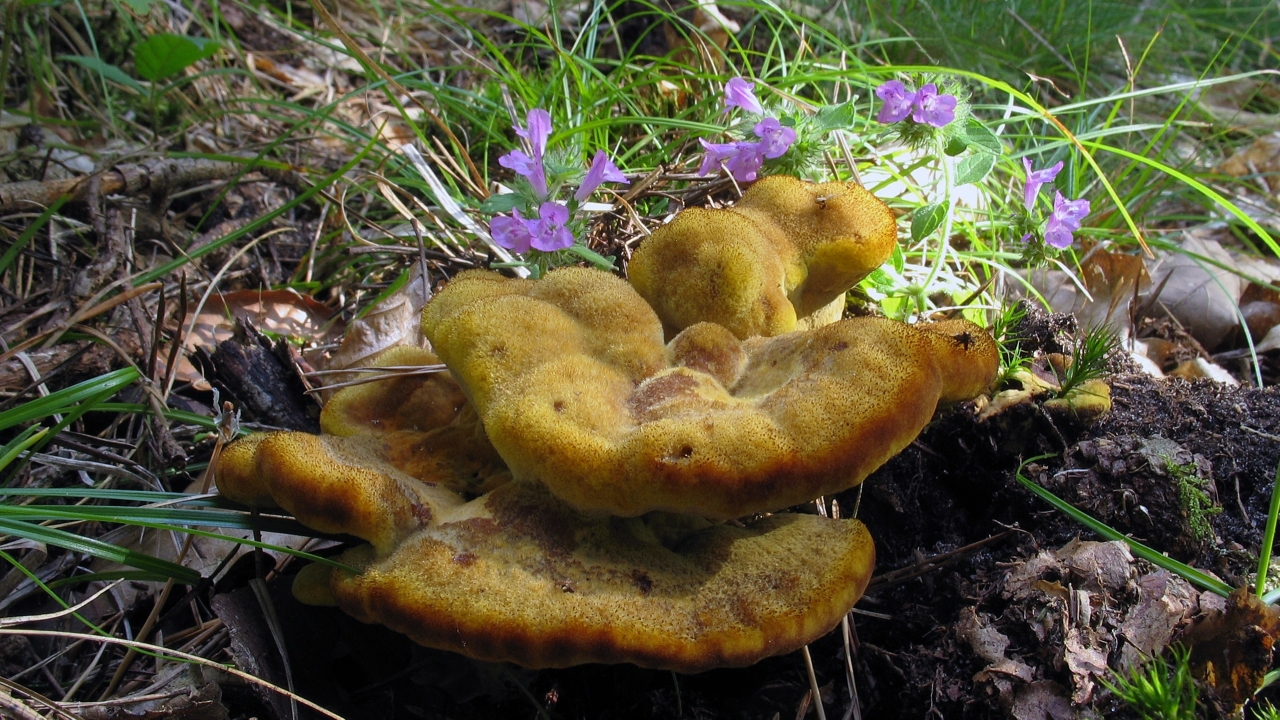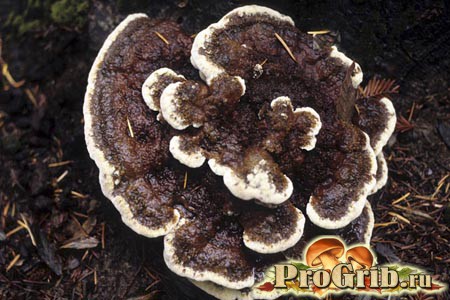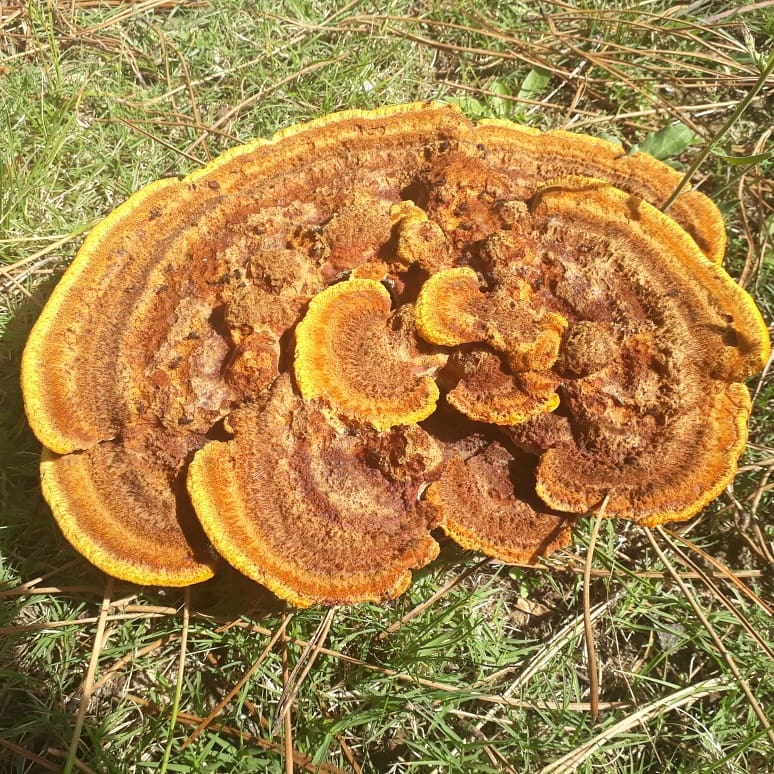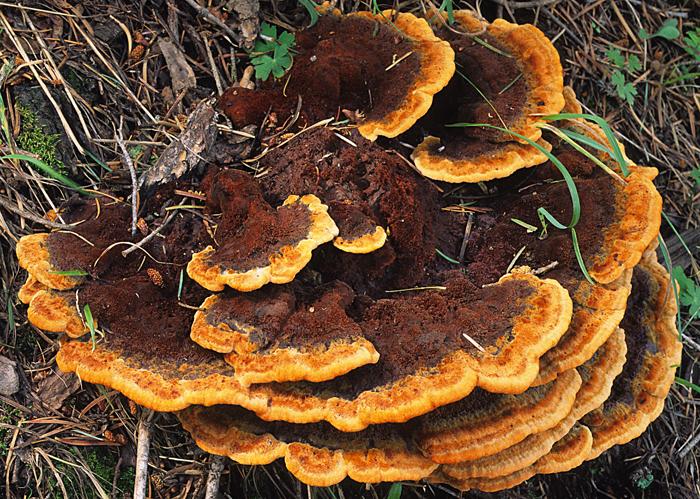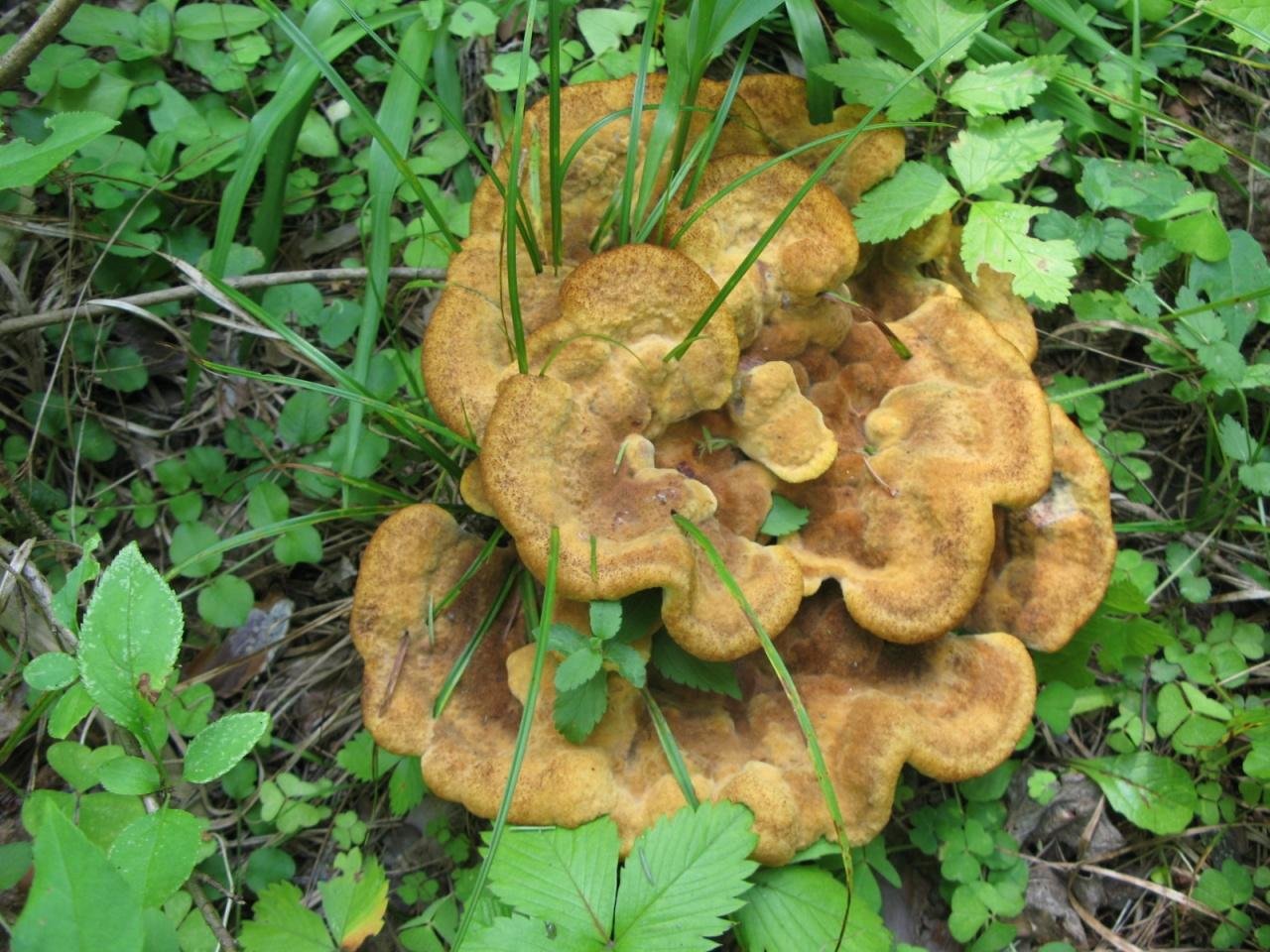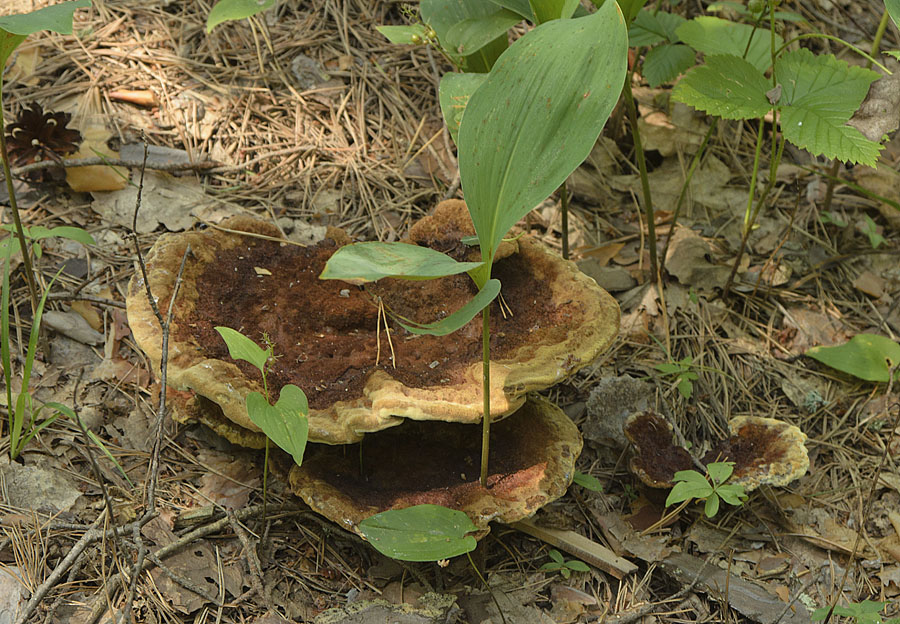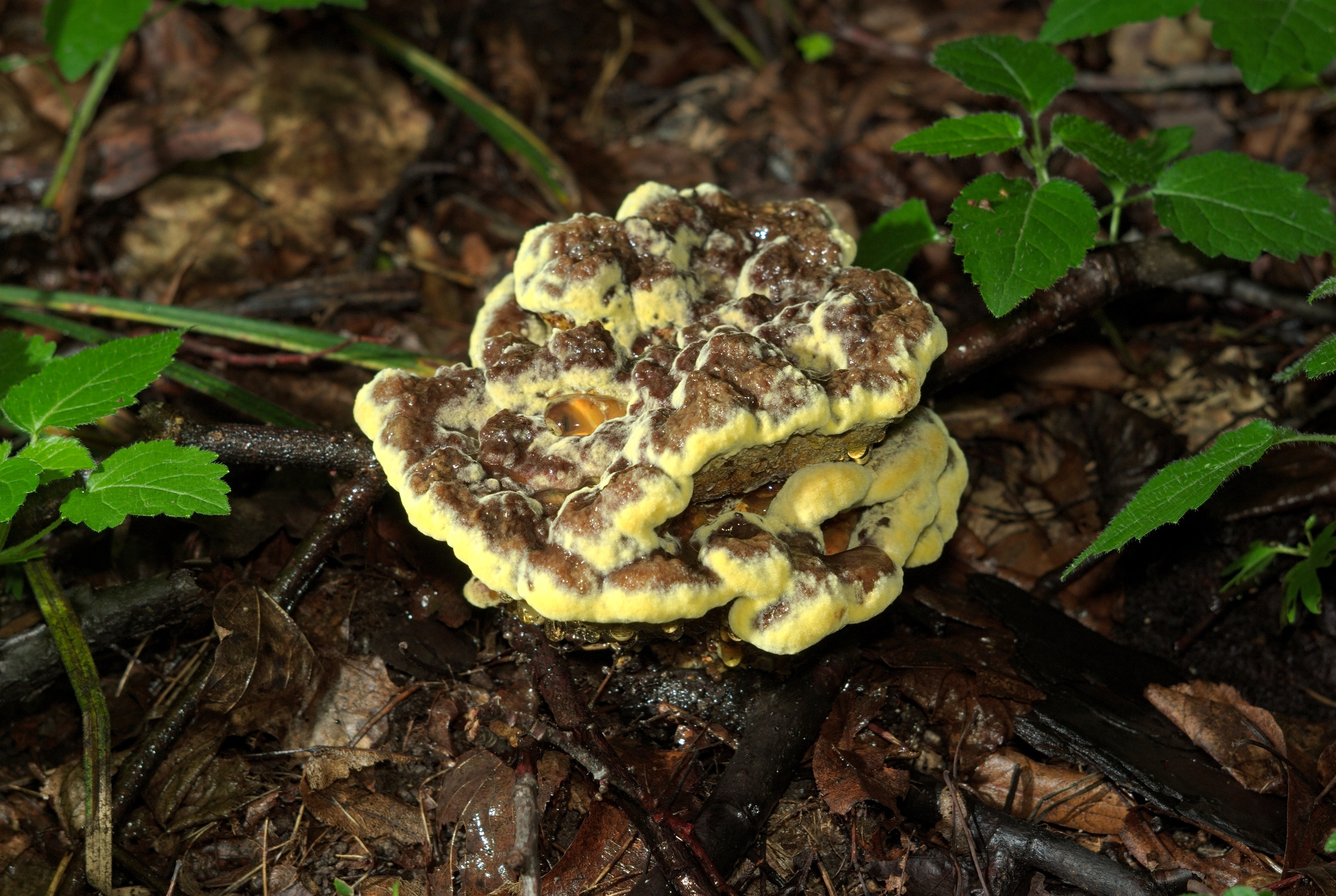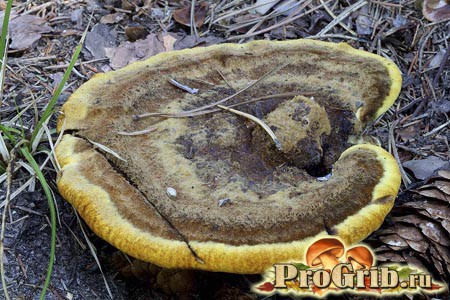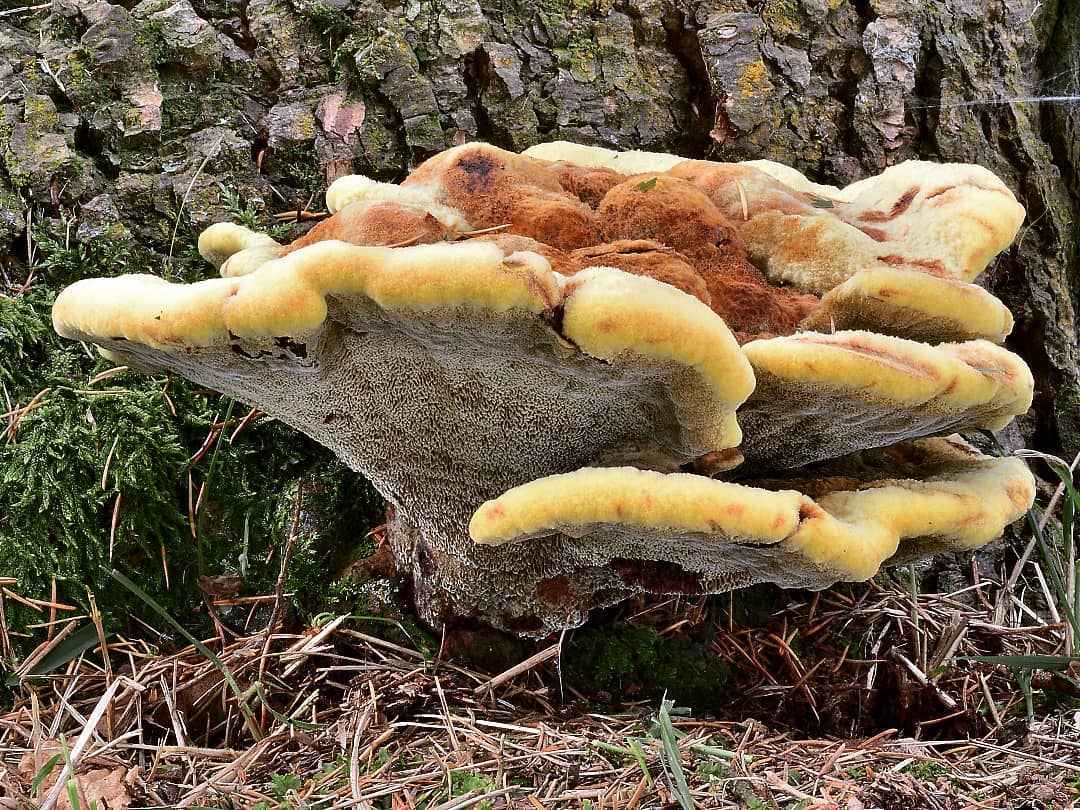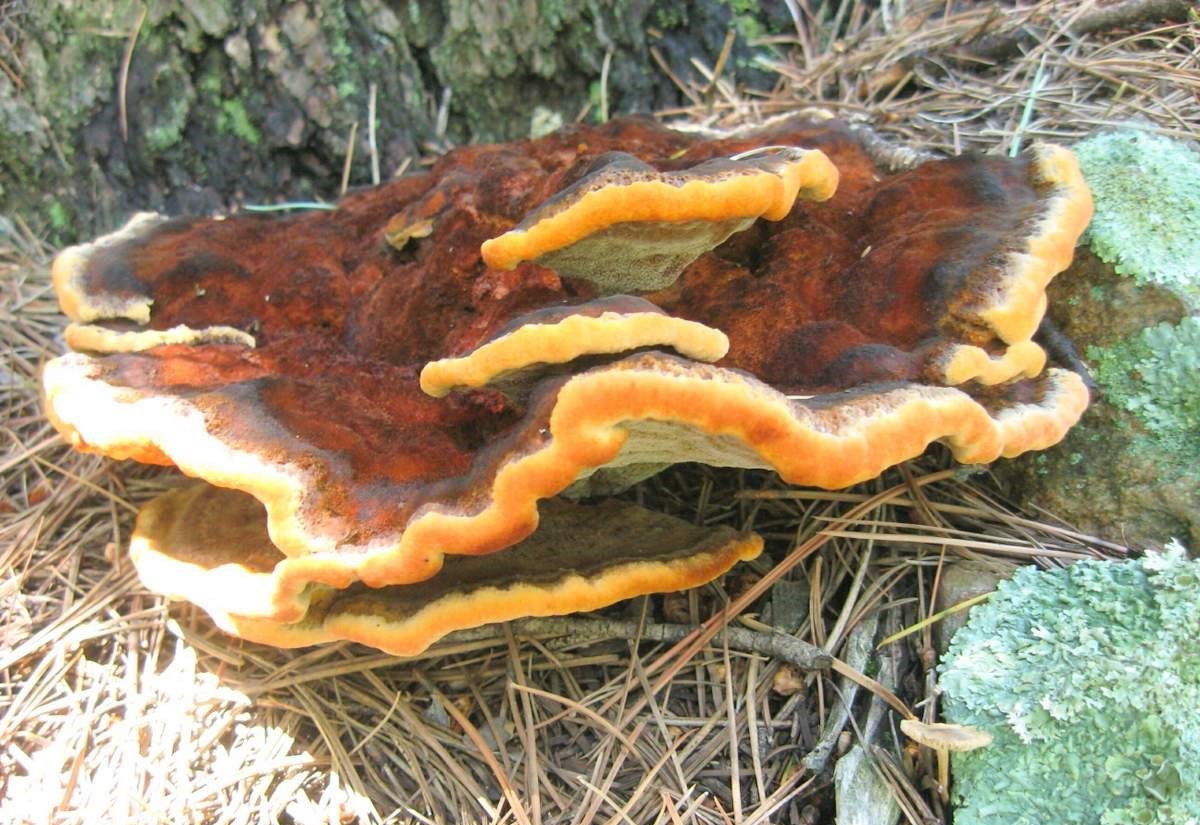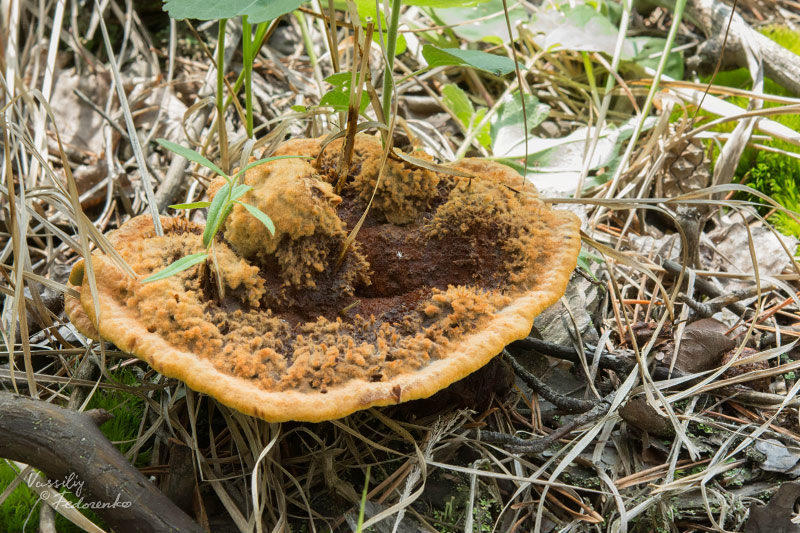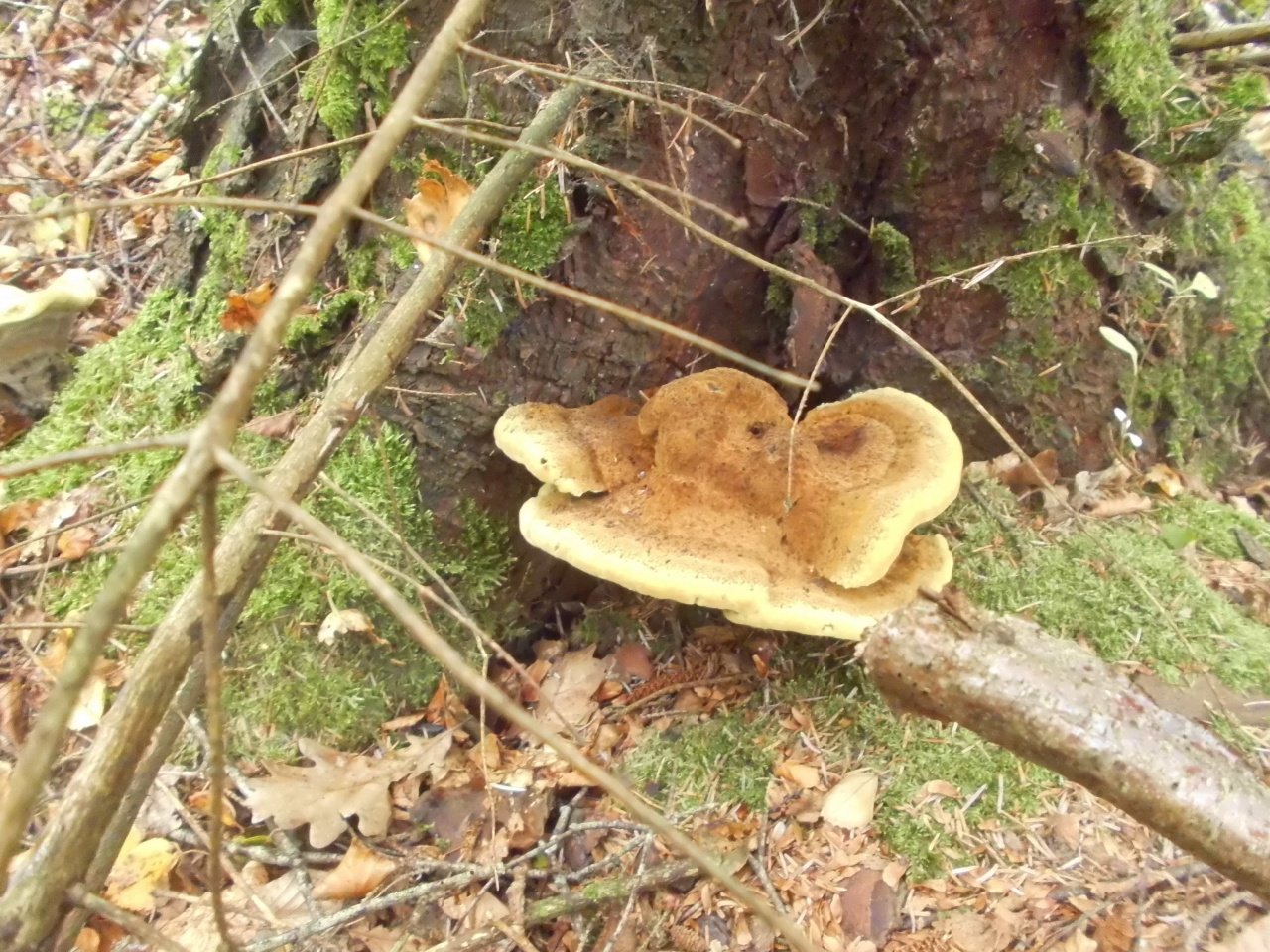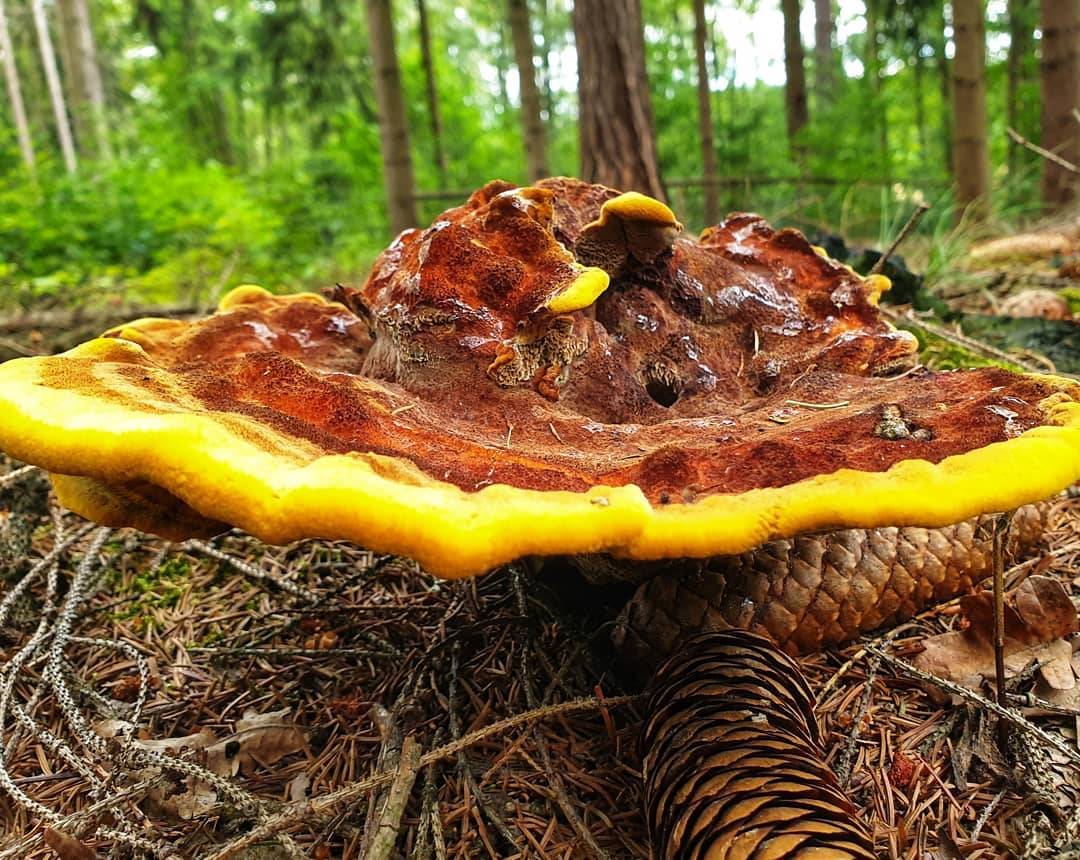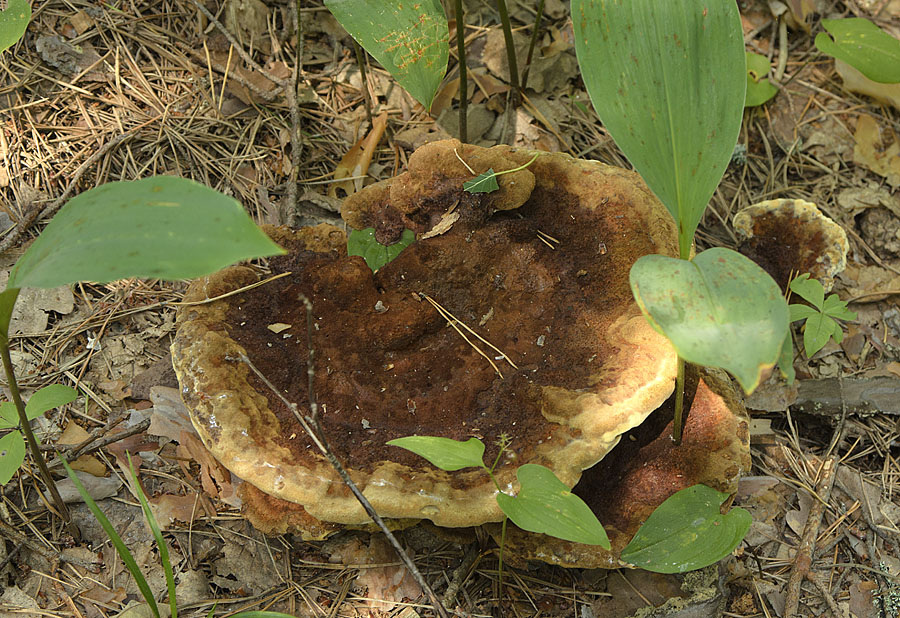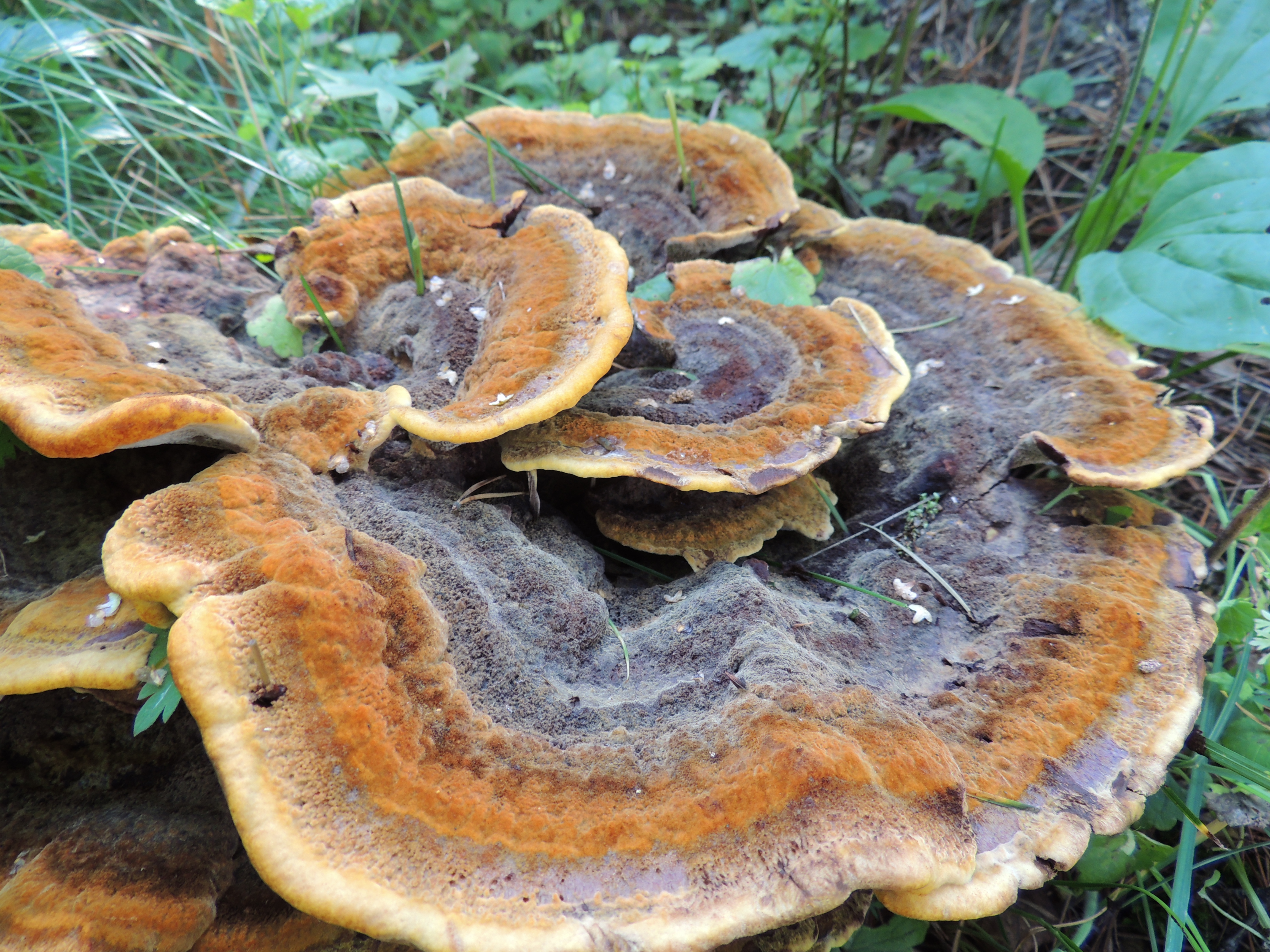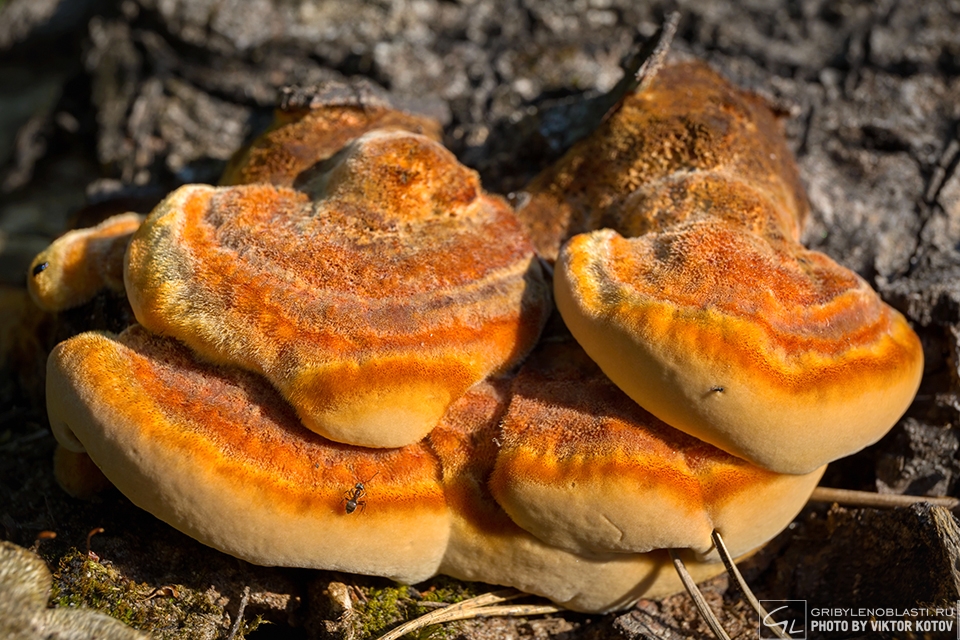Places of growth of tinder fungus Schweinitz.
These are fast growing annual mushrooms. They live in trees, grow in coniferous forests. Found on cedars, pines, larch trees, less often on fir. They can also grow on cherries and plums. These mushrooms can be found at the base of the trunks, often on the roots. They grow in coalescent groups or singly.

Schweinitz polypores are widespread in the temperate northern zone. They grow in Western Europe, Western Siberia and the European part of Russia. Sveinitsa polypores can bear fruit in summer and winter. Fruiting of the Swiss tinder fungus occurs from July to September. At this time, a white felt of germinating spores is visible under the fruit bodies. After sporulation, the fungi gradually destroy the insects.
Influence of Schweinitz tinder fungi on trees.
These polypores are unique - their fruiting bodies are formed not only on wood, but also on soil, at a certain distance from the tree. Tinder fungi are connected with trees by mycelium. Infection of trees occurs through spores when diseased roots come into contact with healthy roots.
The infection of a tree with Schweinitz tinder fungus can be judged by the presence of fungi and by the slope of the trunk, which occurs due to the death of the root system. Sometimes the angle of inclination of the trunk can reach 60 degrees. Most often, the trunk will tilt in the opposite direction from the place where the roots rot. Another sign of infection is cracks in the butt, in which light brown mycelium films are visible. If you knock on a sick tree, then dull sounds are heard.

Tinder fungi cause brown root rot. This decomposes cellulose and lignin. In the initial stages of decay, a strong smell of turpentine is clearly audible. Rot develops slowly, it increases by about 1 centimeter per year, so the disease process is very long, it lasts for decades. In the butt part, rot develops somewhat faster, while the decay process is highly active.
At the final stage of the disease, the wood becomes very fragile, crumbles easily, disintegrates into separate pieces, and can be ground into powder with your fingers. On average, rot affects a tree at a height of 2-2.5 meters. Rot is distributed along the trunk in separate stripes and spots. The size of the rot depends on the duration of the infestation.

Twins of the tinder fungus Sveinitz.
Tinder fungus Schweinitz bears some resemblance to the odorous tinder fungus. In the fragrant tinder fungus, the fruiting body is cushion-shaped, slightly tomentose, up to 20 centimeters in diameter. The color of the odorous tinder fungus is dark brown or black, the edges are orange or golden yellow.

There is also an external resemblance to Pfeifer's tinder fungus. The body of this mushroom is hoof-shaped, large. Its surface is orange-brown concentric zones and white pores. In winter, the mushroom is covered with a yellow waxy film.
Root rot protection
To protect against root rot, it is recommended to carry out a set of preventive and extermination measures aimed at increasing the biological resistance of plantings and eliminating sources of infection:
conduct systematic supervision of the state of plantings, the appearance and spread of root rot;
create optimal conditions for the growth and development of woody plants (timely care, application of fertilizers and microelements, the use of growth stimulants, etc.), excluding their weakening and increasing biological resistance;
prevent trampling and compaction of the soil, which is accompanied by weakening of plants, exposure of root paws and mechanical damage to the roots and root collar of trunks, which are the gateway to infection;
when caring for plantings, the trunks and roots should be protected from mechanical damage through which pathogens of root rot penetrate;
to carry out raking of the litter, along which the rhizomorphs of the autumn mildew can spread and infect healthy plants;
remove from the plantations young drying and shriveled trees along with roots, which are sources of infection;
after cutting down older trees in order to eradicate sources of infection, it is necessary to uproot the stumps together with the roots, followed by their removal and destruction;
the pits formed after the removal of the affected stumps should be treated with a copper-containing fungicide - kartocide and covered with earth;
in the areas vacated after the uprooting of affected stumps, it is recommended to plant trees and shrubs no earlier than 2-3 years later.
Appearance
This mushroom has a cap fruit body. The hat is different in shape. It can be flat, funnel-shaped, rounded or semicircular. Lobe-shaped specimens are also sometimes found. Its diameter can reach 28 cm, and its thickness is approximately 1.3 cm.
On young tinder fungi, the cap is not smooth; it can be woolly or felt. Subsequently, its surface becomes bare. At first, it is painted in a yellowish-rusty color, and then it becomes darker, acquiring a brownish color with a slightly orange or brownish tint. Its edges are yellowish, shiny. In young tinder fungi it is lighter than the rest of the cap surface, and then the color of the surface evens out.
The geminal layer is yellow, and subsequently acquires a brown tint. In thickness it can reach 1 cm. The tubes are short - less than 1 cm. At first they have thick walls, which become thinner with age. Spores can be white, rusty, or yellow-greenish.
If the mushroom has a stem, it is very thick and short. Typically tuber-shaped or tapering, brown in color. But most specimens grow without a stem.
Variety of types and forms
The classification of polypores is based on the order of the basidia. Based on this, mushrooms are divided into hymenomycetes and gasteromycetes. There are several tinder families:
- porium,
- coniophoric,
- polyporous,
- telephonic.
Tinder fungus is a perennial mushroom, but annual representatives can also be found. Annual species grow mainly from June to September. At the end of summer, they begin to deteriorate, turning into insect food. Perennial species do not form a fruiting body immediately. This process takes several months, if not years.
Tinder fungus has impressive dimensions - from 20 cm to 1 m. Weight - from 1 kg to 20 kg. The mushroom can have a wide variety of colors: gray, brown, orange, black, red, yellow, etc.
The surface of the mushroom is very similar to the bark. It can be smooth, velvety and even hairy.
The species diversity of mushrooms is huge. The most popular among them:
- sheep,
- smoky,
- merging,
- scorched
- bordered,
- varnished,
- birch,
- chestnut,
- winter,
- oak,
- odorous,
- vase-like,
- scaly,
- multicolored.
Return
Edible tinder fungus

A common edible species is the sulfur-yellow tinder fungus. This mushroom is edible only when young, it is boiled for 30-45 minutes or fried. The sulfur-yellow tinder fungus has a pleasant mushroom smell and sour taste. It is also used in salads, salted and pickled. Mushroom stuffing based on this type is used as a filling for pies, egg casseroles. In addition, this mushroom keeps well frozen for a long time.
In Germany and North America, sulfur-yellow tinder fungus dishes are delicious. In these regions, the mushroom is known as "wood chicken" or "mushroom chicken". As a substitute for chicken meat, it is used in vegetarian cuisine.
Characteristics of the fungus tinder fungus
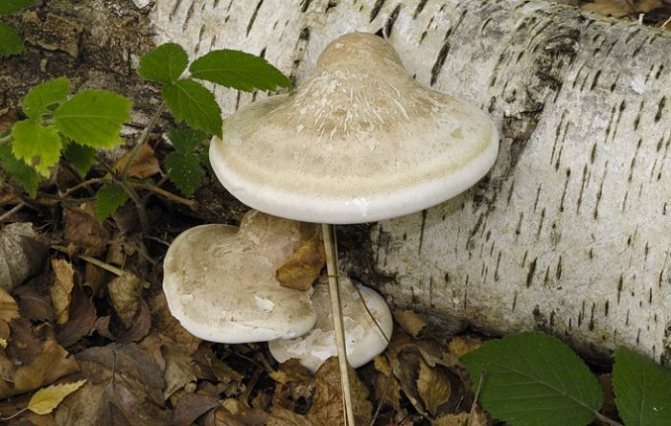
The structure of the fruiting body in polypores is unusual. Moreover, it is resistant to water, high and low temperatures. Thin threads, hyphae, which intertwine with each other, form the body of the fungus. The mycelium is deep in the trunk of the tree.Hyphae penetrate under the bark of a tree, thanks to the release of special enzymes that dissolve the cell membranes.
Fruit bodies are distinguished by shape: sessile (attached to the substrate on one side, sometimes have a lateral leg); spread out (like a plate or a cake that has grown tightly to a tree, and their color and surface are similar to the bark of a tree); hats
Areas of growth of sulfur-yellow tinder fungi.
Sulfur-yellow polypores settle in deciduous forests. The substrate for them is dead or old wood of willow, alder, oak, poplar, ash, walnut, linden, chestnut. Less commonly, these fungi are found on larch and pear trees. Mushroom pickers find these tinder fungi in parks, gardens, forest edges, and even on city streets.

In the Leningrad region, sulfur-yellow tinder fungi are distributed in a dotted manner. They come across quite rarely. They bear fruit from May to early October. They settle in groups, tiled. You can meet sulfur-yellow tinder fungi every year. If there is no drought and hot weather, they can grow throughout the summer.
Sulfur-yellow polypores are widespread throughout the world. They can grow in plains and mountains. They inhabit Europe, central Russia, the Far East, Siberia and North America.
Influence of sulfur-yellow tinder fungi on wood.
These beautiful large mushrooms are tree pests. They cause the development of brown rot on trees. The core of the trunks becomes brittle, it develops a brownish-red color. The trunk is made hollow, crumbles easily and the tree breaks.

Sulfur-yellow tinder fungus twins.
The fused tinder fungi are similar in shape to the northern climacodon. It is an inedible mushroom. The caps of these mushrooms are white or gray-yellow with spines. They have an unpleasant smell. The main stepfather is thin, brittle, often spaced, long spines.
Another relatively similar species is the giant meripilus. This mushroom is brown or yellow-brown in color, white flesh and pale yellow tubules. At a young age, these mushrooms can be eaten, but they are of poor quality.

Evaluation of the edibility of sulfur-yellow tinder fungus.
Young sulfur-yellow tinder fungi are quite suitable for food. But they need to be boiled for 45 minutes. Elastic and more tender fruiting bodies are used in salads, they are salted, fried and pickled. You can also make minced meat for pies from these mushrooms.

To eliminate the sour taste, sulfur-yellow tinder fungi are breaded. To add flavor to the pulp, sprinkle it with spices.
In Germany and in some parts of North America, sulfur-yellow tinder fungi are considered delicious mushrooms. In these places, tinder fungi are called "mushroom chicken" or "tree chicken".
Medicinal properties of sulfur-yellow tinder fungi.
The fruit bodies of sulfur-yellow tinder fungi contain antibiotics. They suppress the growth of tumors and increase immunity.

Toxicity of sulfur-yellow tinder fungi.
Although most commonly considered conditionally edible, these mushrooms can be toxic.
Therefore, sulfur-yellow tinder fungi are recommended to be used limitedly and with caution.
In some sources, sulfur-yellow tinder fungi appear as poisonous mushrooms. They have a laxative effect, sometimes causing swelling of the lips, dizziness and vomiting. Also, sometimes allergic reactions occur when eating these mushrooms. Cases of visual hallucinations are described.

Toxicity may be present in polypores grown on coniferous trees. Also, old fruit bodies, in which the process of decay has already begun, can be poisonous. Sometimes tinder fungi growing on conifers are considered as an independent species and call it coniferous-woody letiporus. This species is considered inedible or poisonous.
In order to avoid poisoning, only young tinder fungi are collected, which have not yet developed an unpleasant odor. Also, you can not collect sulfur-yellow tinder fungus from coniferous trees.
Traditional medicine recipes
To create healing potions, the following medicinal types of tinder fungus are used: real, varnished, birch, larch.These mushrooms are used as an adjuvant for the prevention and treatment of functional disorders.
Express blood purifier
Grind the dried fruit bodies of the mushroom into powder. Reception scheme: 1-2 days - 5 g of raw materials every 2.5 hours with 100 ml of pure water (10 minutes before a meal). From the 3rd day, they switch to a three-time regime of powder consumption (observing the indicated dosage). The course of treatment is 1-2 months. The remedy is effective for poisoning, allergies, infectious pathologies and liver diseases.
Composition for stimulating weight loss and sputum discharge

Pour 15 g of chopped tinder fungus with 200 ml of hot water. Place the container with the mixture in a water bath for 30 minutes. After that, insist the composition in a warm place for at least 4 hours. The finished product is taken four times a day, 15 minutes before meals. In addition to stimulating weight loss, the drug is used to improve sputum discharge in case of pneumonia, bronchitis, pleurisy, tuberculosis.
External remedy for skin lesions
Pour 30 g of mushroom powder with 150 ml of vodka. Insist the mixture in a dark place for 14 days. Strain the finished product through cheesecloth, and then use for irrigation of damaged skin (ulcers, cuts, scratches). In case of suppuration of the dermis, before using the infusion, the wound should be washed with a solution of furacilin (1: 5000) or hydrogen peroxide (3%).
A drug for hepatitis
Soak the dried tinder fungus in cold water (3-4 hours), and then mince it. After that, combine the crushed raw materials (200 g) with warm boiled liquid (1 l). Insist the medicinal mixture for at least 2 days in a dark place. Then strain the solution through a sieve and mix with water in which the mushroom was soaked. The composition is taken 150 ml three times a day (before meals).
Multifunctional mushroom tincture. Combine 50 g of crushed tinder fungus and 500 ml of natural wine (preferably Cahors wine). Insist a sealed container with raw materials for 14 days in a cool place. The infusion is consumed three times a day, 5-15 ml. The course of admission is 3-4 months.
The oil composition helps to get rid of allergic rhinitis, increased blood viscosity, excitability of the heart muscle. Along with this, the agent is used to suppress the tumor process (in the first stages).
Oil composition for atherosclerosis, hypertension, mental disorders
To create an infusion, you will need: 23 g of dried chopped mushrooms and 250 ml of natural olive fat. After mixing, the solution is kept in a dark place for 14-21 days. The oil composition is consumed twice a day, 5-15 ml (depending on the severity of the disease). The course of treatment is 3-4 months.
Antineoplastic tincture
The best materials of the month
- Why you can't go on a diet on your own
- 21 tips on how not to buy a stale product
- How to keep vegetables and fruits fresh: simple tricks
- How to beat your sugar cravings: 7 unexpected foods
- Scientists say youth can be prolonged
Mix 45 g of mushroom powder and 500 ml of vodka. Insist the solution in a dark place for 15 days. Do not filter. To suppress the tumor process, the composition is taken twice a day, 10 ml each (preferably half an hour before meals).
Remember, drugs based on polypores cannot be combined with pain relievers, anticoagulants, antihypertensive drugs, aspirin, antibiotics, amphetamines, or drugs that lower blood sugar. In addition, taking the mushroom should be stopped at least 2 weeks before surgery, including the procedure for removing teeth.
Control methods
To protect thuja from diseases, it is necessary to carry out a set of measures aimed at preventing and limiting their spread:
- use for planting plants that do not show signs of disease and damage to trunks and branches (mechanical wounds, insect damage, etc.);
- systematic supervision of the condition of plants and the appearance of diseases during the growing season;
- creation of optimal conditions for the growth and development of thuja, increasing its resistance to diseases
- timely pruning and destruction of individual dried-up branches that can be sources of infection;
- with a high level of incidence of necrotic diseases, prophylactic spraying during the growing season with copper-containing fungicides with strict adherence to application regulations.
_____________________________________________
Lowland shute spruce needles
Where grows
It is a fast growing mushroom that grows on conifers. Therefore, you can see them in a coniferous forest on a fir or pine. But sometimes they can also grow on plums or cherries. The fungus is usually found at the root or near the base of the tree trunk. They can grow both one by one and several accrete specimens.
Representatives of this species are very often found in temperate climates. They can be seen on trees in Western Europe as well as in western Russia. They also exist in Western Siberia. The fruiting period takes place not only in summer but also in winter. But most of the time is the second half of summer. During this period, spores germinate. After this, the body of the fungus is usually destroyed by insects.
Growing tinder fungus at home
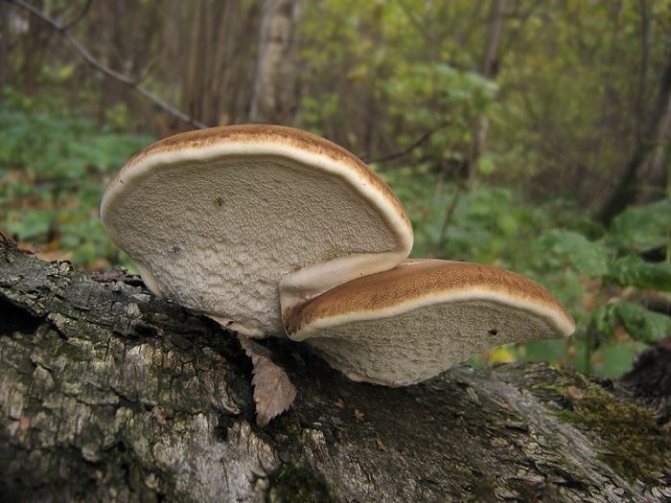
Polypores are grown on a substrate that consists of a mixture of sawdust, shavings, bark of small branches. Such a substrate is poured with boiling water, left to cool to room temperature, after which it is squeezed out, mixed with the mycelium of the fungus and placed in plastic bags. The bags are cut and left in a room with 80% humidity, natural light and an air temperature of + 20 ° C. The first harvest appears after 30-40 days.
Also, hemp and wooden blocks serve as a substrate for growing tinder fungus. It is pre-soaked in water. After that, cuts are made with a saw or a drill, into which the mycelium is laid. Bars with mycelium are left in a shady place, sprinkled with leaves. During the dry season, they are watered. The crop appears 4 months after planting.
Description of the tinder fungus
The fruiting body of the fungus consists of several caps located on one leg. The shape of the cap can vary greatly: there are funnel-shaped, flat, saucer-shaped, rounded, semicircular, irregularly lobed. Maximum dimensions: up to 30 cm in diameter and up to 4 cm in thickness. The upper surface of the cap has a slightly tomentose or bristly-rough structure; it is heavily pubescent or woolly. The color of the cap of the fungus at the initial stage of development is yellow-rusty, sulfur and dark gray-yellow, then almost brown-rusty and rusty brown, in old age it is dark brown, dirty and dark brown, even blackish - darker than the hymenial layer. The fruit body of the fungus is sterile, shiny, sulfur-yellow, at first lighter than the cap, and then the same color as it.
The seamstress has a yellow or sulfur-yellow geminal layer, which turns brown at maturity. The thickness of the above layer of the seamstress is about 1 cm. There are downward tubes, short at a young age, with thick, and then with thin walls. Tubules of the same color with pore edges. The pores of the tinder fungus are very small - 1.5-2 (up to 4) mm in diameter, rounded, cellular, angular or irregular, slightly later sinuous-patterned, with slightly serrated edges. Sewers in youth are greenish-yellow, in maturity - dark brown.
The leg of this species of parasitic fungi is absent at all or wide, short, tuberous, tapering downward, covered with fluff, more or less central, brown in color. The flesh of the tinder fungus is soft, spongy, even flabby, at first saturated with moisture, and gradually hardening with age - hard-fibrous. When dried, the tinder fungus becomes brittle, crumbly, very light, fibrous, yellow, orange, yellowish brown, dark rusty or brown.
Thuja pests
Most thuja pests are oligophagous and can develop on plant species from the cypress family: junipers, thuja and cypress trees. They occur and harm mainly in the southern regions of the European part of Russia, in the Crimea and the Caucasus.
A few pests of thuja belong to three ecological groups:
- sucking
- minerals,
- xylophages.
Sucking pests of thuja suck the juices from needles, shoots and immature cones. These include two species of coccids and one species of aphids.
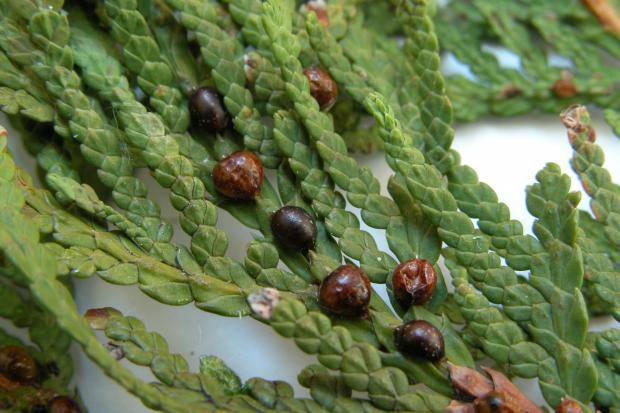
Thuya false shield
The most harmful to the thuja are the juniper scabbard (Carulaspis juniperus) and the thuja false scutellum (Parthenolecanium fletcheri). In the juniper scale, the scutellum of the female is brown, elongated-oval, 1.9–2.0 mm long. This species is found in the southern regions of the European part of Russia, in the Caucasus and Central Asia. In thuja false scutellum, the body of the female is strongly convex, almost spherical, 3–3.5 mm long, yellowish-brown and brown in color. This false shield is found and damages in the parks of the European part of Russia, forests and parks of the Crimea, the Caucasus and Central Asia.
Thuja aphids (Cinara juniperina) can be found much less often on thujas. This species belongs to monoecious non-migratory aphids. The integument of the body of the pest is grayish-brown, with a light waxy coating. Aphids feed on small colonies on the underside of 2-3-year-old shoots. The needles on the shoots damaged by aphids gradually turn yellow and eventually fall off. Thuja aphids are found everywhere.
Miner insects
Miners are insects whose larvae feed on the tissue of leaves or needles, making passages in the thickness of leaf blades or a growing shoot.
The scaly leaves of the thuja gnaw inside the tiny caterpillars of the thuja miner moth (Argyresthia thuiella). The tracks of the caterpillars are clearly visible when looking at the needles into the light. Damaged needles turn brown (turn yellow), and the tops of its shoots die off. After the caterpillar emerges, well-visible small holes remain in the yellowed needles. The harm is insignificant. Thuja mining moth is found everywhere.
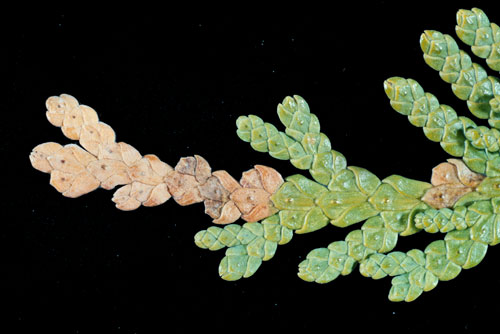
Damage from thuja miner moth
Stem pests
Stem pests, or xylophagous insects, feed on the bark, bast and wood of branches and trunks. Most of them settle on strongly weakened and dying plants. Three species of bark beetles are known on thujas: the bark beetle (Phloeosinus thujae), the juniper bark beetle (Phloeosinus aubei), which can be found only in the forests and parks of the Crimea and the Caucasus.
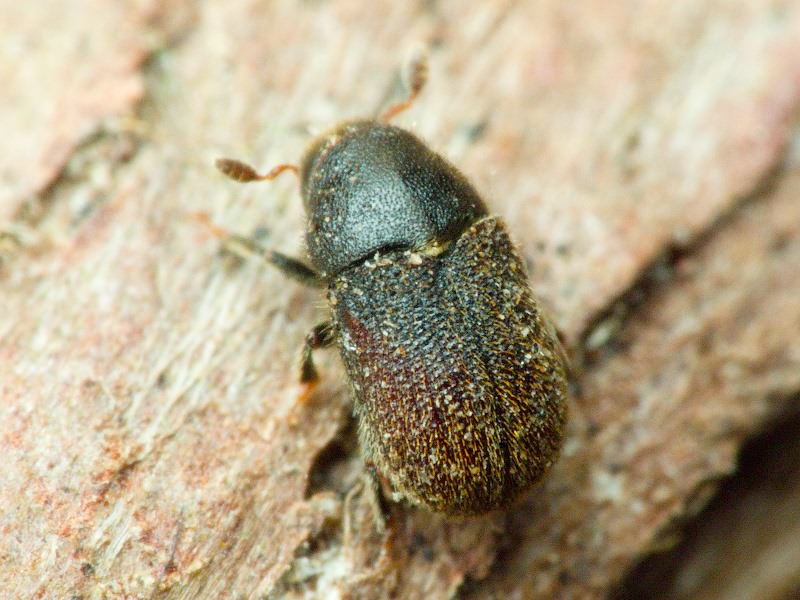
Thuja bark beetle
Thuja diseases
Young shoots and leaves, which turn yellow or acquire a reddish-brown color, are affected. Sporulation of the pathogen is formed on rounded dying areas of the bark and leaves, which looks like crowded black-brown rounded tubercles with a diameter of up to 0.3 mm protruding from the breaks of the integumentary tissues.
Pestalocyopsis necrosis (causative agent - fungus Pestalotiopsis funerea)

Pestalocyopsis necrosis
Young shoots and leaves, which acquire a light brown or reddish brown color, are affected. Leaf damage begins from the top of the shoots, spreading downward. On dying and dead leaves and bark, sporulation of the fungus is formed in the form of a few scattered black rounded tubercles with a diameter of up to 0.2 mm protruding from cracks in the integumentary tissues. Mature spores emerge on the surface of affected leaves and shoots in the form of dark brown, almost black drops and thin cords, which are a characteristic sign of the disease.
Phomopsis necrosis (causative agent - fungus Phomopsis juniperovora)
Affected shoots and leaves turn brown. On the dead bark and in the axils of the leaves, sporulation of the pathogen is formed in the form of black rounded tubercles. Mature spores emerge on the surface of the affected organs in the form of light droplets or strands.
Cytospore necrosis, or osteoporosis (caused by fungi from the genus Cytospora)
Mostly trunks and branches are affected, less often - leaves, which acquire a brown color. The disease is detected by the sporulation of pathogens, which look like numerous, very small conical tubercles with dark tops. Mature spores come to the surface in the form of well-visible golden-yellow, orange or reddish drops, thin flagella and spirals. (Read more about the disease in one of our articles).
Diplodious necrosis, or diplodiosis (causative agent - the fungus Diplodia thujae)
The bark of trunks, branches and leaves is affected. The color of the bark hardly changes, and the leaves turn brown or reddish-brown. In the dead areas, sporulation of the pathogen is formed, which looks like numerous scattered black rounded tubercles with a diameter of up to 0.5 mm.
Brown shute (causative agent - mushroom Herpotrichia juniperi)
The pathogen develops in winter under the snow, therefore, the leaves of only that part of the crown that is in the snow cover zone in winter are affected.After the snow melts, the infected leaves are covered with dense dark brown mycelium (mycelium), which, as it were, glues the affected shoots. On the mycelium, the fruiting bodies of the fungus are formed in the form of black spherical small tubercles, poorly distinguishable on the brown mycelium. Over time, the mycelium is destroyed, and dirty brown scraps remain on the affected leaves.
Mature thuja trees can become infected with wood-destroying fungi, of which root rot pathogens are the most dangerous: autumn honey fungus (Armillaria mellea), root sponge (Heterobasidion annosum), flat tinder fungus (Ganoderma lipsiense), Schweinitz tinder fungus (Phaeolus schweinitzii).
 Mushroom on the trunk
Mushroom on the trunk 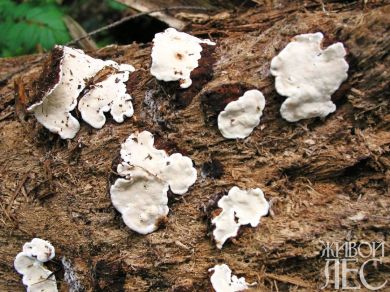 Fruit bodies of the root sponge Fruit body of the tinder fungus
Fruit bodies of the root sponge Fruit body of the tinder fungus
All these diseases occur, as a rule, against the background of a preliminary weakening of thuja caused by various unfavorable factors (weather conditions, imbalance of nutrients in the soil, damage by pests, etc.).
Literature
Wikimedia Foundation. 2010.
See what "Tinder Schweinitz" is in other dictionaries:
False tinder fungus - Phellinus igniarius see also Genus Phellinus Phellinus Quel. False polypore P. igniarius (L .: Fr.) Quel Fruit bodies are perennial, first lumpy spherical, then hoof-shaped, sessile, up to 25 cm in diameter and up to 12 cm thick, at first ... ... Mushrooms of Russia. Directory
Theolus Schwenitz, tinder fungus felt-brown - Phaeolus schweinitzn (Fr.) Pat see also Genus Theolus Phaeolus Pat. Theolus Schwenitzn, brown felt tinder P. schweinitzn (Fr.) Pat. Fruit bodies in the form of single caps or collected in groups on a common short central stalk. Hats ... ... Mushrooms of Russia. Directory
Polypores - Paraphyletic group of mushrooms Multicolored polypore ... Wikipedia
Hymenochete tobacco - Hymenochaete tabacina (Fr.) Lev see also Genus hymenochet Hymenochaete Lev. Hymenocheta tobacco H. tabacina (Fr.) Lev. Fruiting bodies are annual, prostrate or prostrately bent in the form of tiled lateral caps, thin ... Mushrooms of Russia. Directory
Chaga, birch mushroom - Inonotus obliquus (Fr.) Fil. f. sterilis (Van.) Nikol see also Genus inonotus Inonotus Karst. Chaga, birch mushroom I. obliquus (Fr.) Fil. f. sterilis (Van.) Nikol. The sterile form of the beveled tinder fungus (/. Obliquus) is ... ... Mushrooms of Russia. Directory
Two-year-old drywort - Coltricia pemuris (L .: ft.) Murr see also Coltricia genus, Coltricia S.F. The hat is 2-10 cm in diameter, round, flat or funnel-shaped, zonal, finely velvety, later ... ... Mushrooms of Russia. Directory
Table 13 - 70 hymenochete tobacco; 71 chaga, birch mushroom; 72 false tinder fungus; 73 two-year-old dry-house; 74 Theolus Schweinitz ... Mushrooms of Russia. Directory

